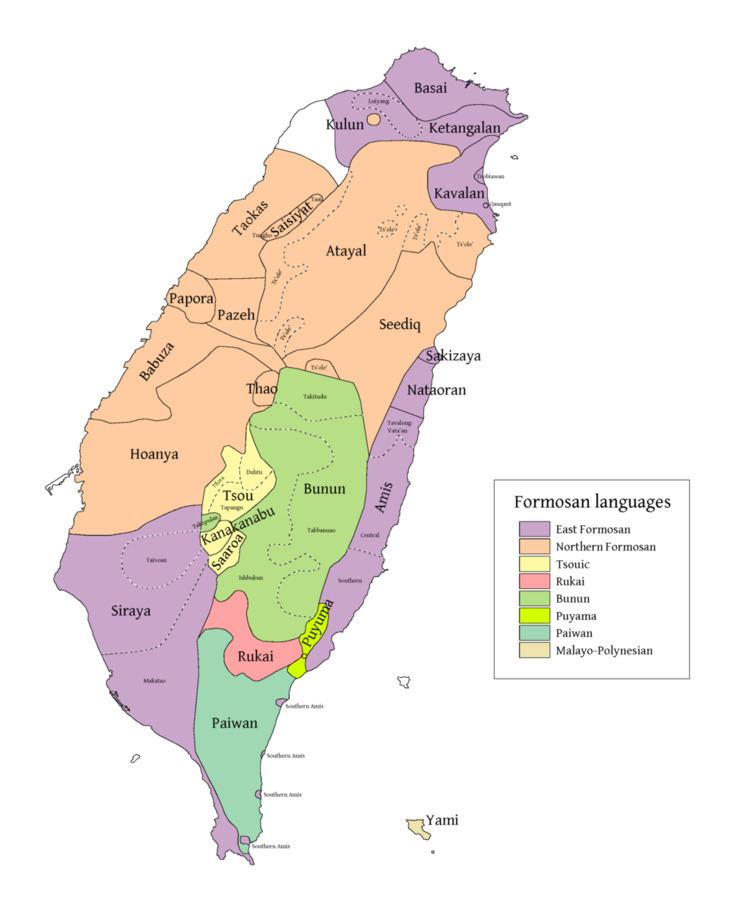Native speakers 66,000 (2002) Glottolog paiw1248 | Ethnicity Paiwan ISO 639-3 pwn | |
 | ||
Language family AustronesianPaiwanic ?Paiwan | ||
Paiwan is a native language of Taiwan, spoken by the Paiwan people, one tribe of the Taiwanese aborigines. Paiwan is a Formosan language of the Austronesian language family. The number of speakers is estimated to be 66,000.
Contents
Dialects
Paiwan variants can be divided into the following dialect zones (Ferrell 1982:4–6).
Phonology
Kuɬaɬau Paiwan has 23–24 consonants (/h/ is found only in loanwords, and /ʔ/ is uncommon) and 4 vowels (Ferrell 1982:7). Unlike many other Formosan languages that have merged many Proto-Austronesian phonemes, Paiwan preserves most Proto-Austronesian phonemes and is thus highly important for reconstruction purposes.
The four Paiwan vowels are /i ə a u/. /ə/ is written e in the literature.
In Northern Paiwan the palatal consonants have been lost, though this is recent and a few conservative speakers maintain them as allophonic variants (not as distinct phonemes). /ʔ/ is robust, unlike in other Paiwan dialects where its status is uncertain, as it derives from *q.
Younger speakers tend to pronounce /ʎ/ as [l]. Fricative [ɣ] is characteristic of Mudan village; elsewhere is Southern Paiwan it tends to be a trill [r], though it still varies [r ~ ɣ ~ ʁ ~ h]. Word-initial *k has become /ʔ/.
Pronouns
The Paiwan personal pronouns below are from Ferrell (1982:14).
Function words
Paiwan has 3 construction markers, which are also known as relational particles (Ferrell 1982:13).
- a – shows equational relationship; personal sing. = ti, personal plural = tia
- nua – shows genitive / partitive relationship; personal sing. = ni, personal plural = nia
- tua – shows that the relationship is neither equational nor genitive; personal sing. = tjai, personal plural = tjaia
Other words include:
Affixed adverbials include (Ferrell 1982:14):
Interjections include (Ferrell 1982:12):
Verbs
Paiwan verbs have 4 types of focus (Ferrell 1982:30).
- Agent/Actor
- Object/Goal/Patient
- Referent: spatial/temporal locus, indirect object, beneficiary
- Instrument/Cause/Motivation/Origin
The following verbal affixes are used to express varying degrees of volition or intent, and are arranged below from highest to lowest intention (Ferrell 1982:37).
- ki- (intentional)
- pa- (intentional)
- -m- (volitionally ambiguous)
- si- (volitionally ambiguous)
- ma- (non-intentional)
- se- (non-intentional)
Paiwan verbs can also take on the following non-derivational suffixes (Ferrell 1982:13).
Affixes
The Paiwan affixes below are from the Kulalao dialect unless stated otherwise, and are sourced from Ferrell (1982:15–27).
The following affixes are from the Tjuabar dialect of Paiwan, spoken in the northwest areas of Paiwan-occupied territory (Comparative Austronesian Dictionary 1995).
